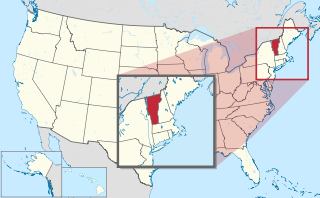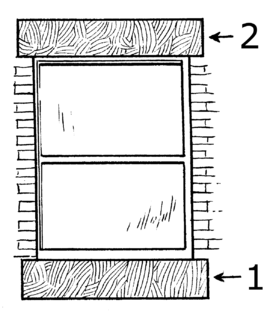
Fairgrove is a village in Tuscola County in the U.S. state of Michigan. The population was 563 at the 2010 census. The village is located within Fairgrove Township.

Chellberg Farm is a historic farmstead which in 1972 became part of Indiana Dunes National Park. Chellberg Farm is significant as it represents the ethnic heritage of a nearly forgotten Swedish-American settlement. The farm includes a family home, water house with windmill, chicken coop/bunkhouse, and the original barn. Other nearby Swedish landmarks have been restored or preserved, including the Burstrom Chapel and the Burstrom Cemetery.

The Church of Our Saviour, also known as the Church of Our Saviour at Mission Farm, the Mission of the Church of Our Saviour and the Josiah Wood, Jr., Farm, is an historic Episcopal church and farm complex located at 316 Mission Farm Road, in Killington, Vermont. The church is a Gothic Revival stone building, built in 1894-95 of Vermont granite. In addition to the church, the 170-acre (69 ha) Mission Farm property includes a c. 1817 farmhouse, a guest and retreat house, a vicarage, a bakery and agricultural buildings. On October 29, 1992, it was added to the National Register of Historic Places. The Church of Our Saviour is part of the Three Rivers Regional Ministry of the Episcopal Diocese of Vermont, and the Rev. Lee Allison Crawford is the vicar.
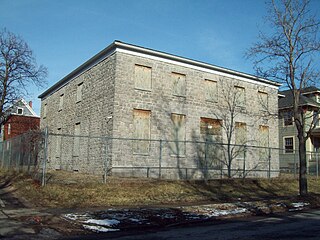
Stone Farmhouse is an historic home located at Buffalo in Erie County, New York. It is a Greek Revival influenced stone vernacular farmhouse. It is a two-story, rectangular hipped roof structure measuring approximately 40 feet wide and 50 feet deep. It was built about 1830–1850 and is one of at least two stone houses in Buffalo surviving from the early 19th century.
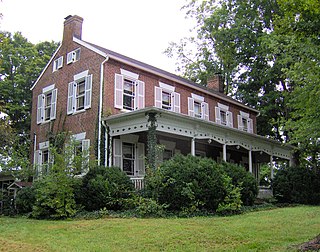
Wheatlands is an antebellum plantation in Sevier County, in the U.S. state of Tennessee. The plantation's surviving structures— which include the plantation house, a storage shed, and smokehouse— have been placed on the National Register of Historic Places. The plantation house has been called "the best example of a Federal-style building remaining in Sevier County."
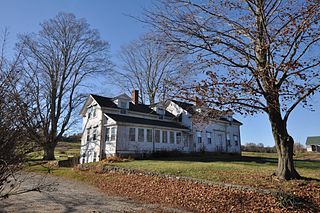
The Metcalf–Franklin Farm is an early 1800s historic farm at 142 Abbott Run Valley Road in Cumberland, Rhode Island. It has been farmed by two family owners, the Metcalf family and the Franklin family. It consists of a small complex of farm buildings on two parcels of land, located on either side of Abbott Run Valley Road and totaling over 63.35 acres (25.64 ha) with an additional 2 acres surrounding the farmhouse.

The Craver Farmstead was established circa 1790 consisting of 225 acres with a farmhouse and a barn. Today, the Craver Farmstead is both architecturally and historically significant. The farmhouse was built prior to 1790 and stands as one of the oldest and best preserved examples of Federal-style architecture in upstate New York. The Federal style evolved as the dominant classicizing architecture in North America between 1780 and1830 as the new republic of the United States sought to define itself as independent in literature, art, and architecture just as it was politically.
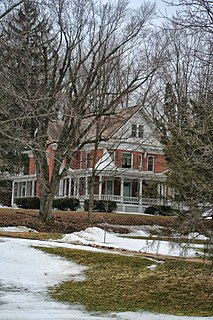
The Freitag Homestead is a historic farm begun in 1848 in the town of Washington, Green County, Wisconsin. It is also the site of the first Swiss cheese factory in Wisconsin. The farm was added to the National Register of Historic Places in 2005.
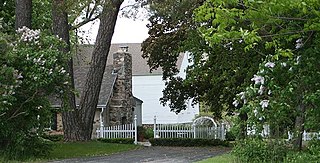
The William F. Jahn Farmstead is located in Mequon, Wisconsin, United States. The farmstead includes a farmhouse, two barns, a summer kitchen, and two outbuildings. The farmstead is not longer used for agriculture, portions have been converted to bed and breakfast lodging.

The Jacob Voigt House is a historic farm located in Mequon, Wisconsin, United States. It was added to the National Register of Historic Places in 2000.

The Helvig–Olson Farm Historic District is an agricultural historic district located in rural Clinton County, Iowa, United States, 3 miles (4.8 km) southwest of the town of Grand Mound. It was listed on the National Register of Historic Places in 2000.

The Carstens Farmstead is a collection of historic buildings located south of Shelby, Iowa, United States. Johan Carstens was a German immigrant who spent eight years living and working in Milwaukee, Chicago, and Davenport, Iowa before settling in Pottawattamie County in 1871, where he established this farm. He bought 160 acres (65 ha) of land from the Chicago, Rock Island and Pacific Railroad, and continued to farm it until he and his wife retired in 1905. The farm remained in the Carstens family until 1977, when the last of the 80 acres (32 ha) was donated to the Pottawattamie County Historical Society. The farm buildings include: the original farmhouse (1872), the 1888 farmhouse with the summer kitchen, an outhouse, garage (1917), granary (1898), horse and dairy barn (1886), beef cattle barn (1903), beef cattle barn (1917), forge and workshop, windmill (1916), feed shed (1919), hog house (1919), poultry house, machine shed (1920), the cob house (1926), and a corn crib (1930). The buildings were listed together on the National Register of Historic Places in 1979.
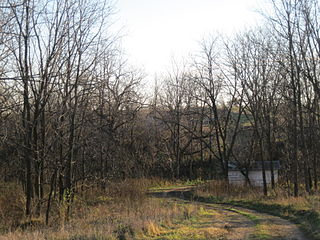
The Mottley Family Farmstead on Ivey Road in Willow Springs in Lafayette County, Wisconsin is a 8 acres (3.2 ha) property which was listed on the National Register of Historic Places in 2001. The listing included three contributing buildings.

The John Sweet Donald Farmstead is a historic farm in Springdale, Wisconsin with surviving structures built as early as 1858. It is significant as the home and testing grounds of John Sweet Donald, a farmer, statesman, and educator of the Progressive Era.
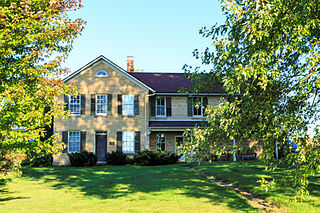
The John Fritz Farmstead is located in Montrose, Wisconsin. It was added to the National Register of Historic Places, along with the State Register of Historic Places, in 1998.

The Lockwood Barn is located in Rutland, Wisconsin.
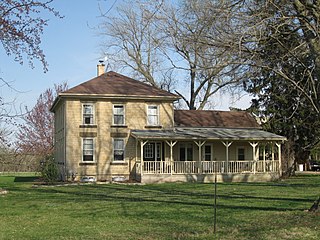
The Samuel Hunt House is located in Rutland, Wisconsin.

The Gulbrand and Bertha Jensvold House is a historic farmhouse built in 1868-69 in Perry, Wisconsin. It was added to the State Register of Historic Places in 2007 and to the National Register of Historic Places the following year.

The Frederick Schumann Farmstead is a well-preserved saltbox-shaped stone farmhouse built by a German immigrant family in 1878 in Berry, Wisconsin. In 1993 it was listed on the National Register of Historic Places.






